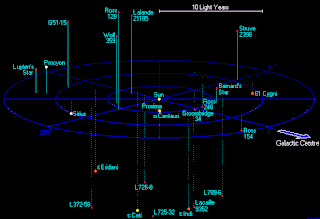External links
- A exhaustive table of 70+ ways of expressing "thousand years (ago)" in scientific papers (2023) with links to papers and appraisals
- How Many? A Dictionary of Units of Measurement, K
The abbreviation kyr means "thousand years".
kyr was formerly common in some English language works, especially in geology and astronomy, for the unit of 1,000 years or millennium. The "k" is the unit prefix for kilo- or thousand with the suffix "yr" simply an abbreviation for "year".
Occasionally, the "k" is shown in upper case, as in "100 Kyr"; this is an incorrect usage. "kyr" itself is often considered incorrect, with some preferring to use "ky".
ISO 80000-3 recommends usage of ka (for kiloannum), which avoids the implicit English bias of "year" by using a Latin root.
An abbreviation is a shortened form of a word or phrase, by any method. It may consist of a group of letters or words taken from the full version of the word or phrase; for example, the word abbreviation itself can be abbreviated as abbr., abbrv., or abbrev.. It may also consist of initials only, a mixture of initials and words, or words or letters representing words in another language. Some types of abbreviations are acronyms or grammatical contractions or crasis.

The terms anno Domini (AD) and before Christ (BC) are used when designating years in the Julian and Gregorian calendars. The term anno Domini is Medieval Latin and means "in the year of the Lord" but is often presented using "our Lord" instead of "the Lord", taken from the full original phrase "anno Domini nostri Jesu Christi", which translates to "in the year of our Lord Jesus Christ". The form "BC" is specific to English, and equivalent abbreviations are used in other languages: the Latin form, rarely used in English, is Ante Christum natum (ACN) or Ante Christum (AC).
Common Era (CE) and Before the Common Era (BCE) are year notations for the Gregorian calendar, the world's most widely used calendar era. Common Era and Before the Common Era are alternatives to the original Anno Domini (AD) and Before Christ (BC) notations used for the same calendar era. The two notation systems are numerically equivalent: "2024 CE" and "AD 2024" each describe the current year; "400 BCE" and "400 BC" are the same year.

The kilogram is the base unit of mass in the International System of Units (SI), having the unit symbol kg. It is a widely used measure in science, engineering and commerce worldwide, and is often simply called a kilo colloquially. It means 'one thousand grams'.
K, or k, is the eleventh letter in the Latin alphabet, used in the modern English alphabet, the alphabets of other western European languages and others worldwide. Its name in English is kay, plural kays. The letter K usually represents the voiceless velar plosive.
A metric prefix is a unit prefix that precedes a basic unit of measure to indicate a multiple or submultiple of the unit. All metric prefixes used today are decadic. Each prefix has a unique symbol that is prepended to any unit symbol. The prefix kilo-, for example, may be added to gram to indicate multiplication by one thousand: one kilogram is equal to one thousand grams. The prefix milli-, likewise, may be added to metre to indicate division by one thousand; one millimetre is equal to one thousandth of a metre.

A year is the time taken for astronomical objects to complete one orbit. For example, a year on Earth is the time taken for Earth to revolve around the Sun. Generally, a year is taken to mean a calendar year, but the word is also used for periods loosely associated with the calendar or astronomical year, such as the seasonal year, the fiscal year, the academic year, etc. The term can also be used in reference to any long period or cycle, such as the Great Year.

The is a grammatical article in English, denoting persons or things that are already or about to be mentioned, under discussion, implied or otherwise presumed familiar to listeners, readers, or speakers. It is the definite article in English. The is the most frequently used word in the English language; studies and analyses of texts have found it to account for seven percent of all printed English-language words. It is derived from gendered articles in Old English which combined in Middle English and now has a single form used with nouns of any gender. The word can be used with both singular and plural nouns, and with a noun that starts with any letter. This is different from many other languages, which have different forms of the definite article for different genders or numbers.

In science and engineering, the parts-per notation is a set of pseudo-units to describe small values of miscellaneous dimensionless quantities, e.g. mole fraction or mass fraction. Since these fractions are quantity-per-quantity measures, they are pure numbers with no associated units of measurement. Commonly used are parts-per-million, parts-per-billion, parts-per-trillion and parts-per-quadrillion. This notation is not part of the International System of Units (SI) system and its meaning is ambiguous.
English number words include numerals and various words derived from them, as well as a large number of words borrowed from other languages.
An order of magnitude of time is usually a decimal prefix or decimal order-of-magnitude quantity together with a base unit of time, like a microsecond or a million years. In some cases, the order of magnitude may be implied, like a "second" or "year". In other cases, the quantity name implies the base unit, like "century". In most cases, the base unit is seconds or years.
Estonian orthography is the system used for writing the Estonian language and is based on the Latin alphabet. The Estonian orthography is generally guided by phonemic principles, with each grapheme corresponding to one phoneme.
Mya is an abbreviation for million years ago, a unit of time equal to 1,000,000 years (i.e. 1×106 years), or 31.556926 teraseconds. It is equivalent to one megaannum (symbol Ma), based on the metric prefix mega-.
The SAO/NASA Astrophysics Data System (ADS) is an online database of over 16 million papers developed by the National Aeronautics and Space Administration (NASA) on astronomy and physics. Abstracts are freely available for most articles, and fully scanned articles may be available in Graphics Interchange Format (GIF) and Portable Document Format (PDF). Hosted papers may be from peer reviewed and/or non-peer-reviewed sources. ADS is managed by the Smithsonian Astrophysical Observatory.

Scribal abbreviations or sigla are abbreviations used by ancient and medieval scribes writing in various languages, including Latin, Greek, Old English and Old Norse.
bya or b.y.a. is an abbreviation for "billion years ago". It is commonly used as a unit of time to denote length of time before the present in 109 years. This initialism is often used in the sciences of astronomy, geology, and paleontology.
The Latin adverb sic inserted after a quoted word or passage indicates that the quoted matter has been transcribed or translated exactly as found in the source text, complete with any erroneous, archaic, or otherwise nonstandard spelling, punctuation, or grammar. It also applies to any surprising assertion, faulty reasoning, or other matter that might be interpreted as an error of transcription.

Aryabhatiya or Aryabhatiyam, a Sanskrit astronomical treatise, is the magnum opus and only known surviving work of the 5th century Indian mathematician Aryabhata. Philosopher of astronomy Roger Billard estimates that the book was composed around 510 CE based on historical references it mentions.

A light-year, alternatively spelled light year (ly), is a unit of length used to express astronomical distances and is equal to exactly 9,460,730,472,580.8 km, which is approximately 5.88 trillion mi. As defined by the International Astronomical Union (IAU), a light-year is the distance that light travels in a vacuum in one Julian year. Because it includes the word "year", the term is sometimes misinterpreted as a unit of time.

The kilometre per hour is a unit of speed, expressing the number of kilometres travelled in one hour.